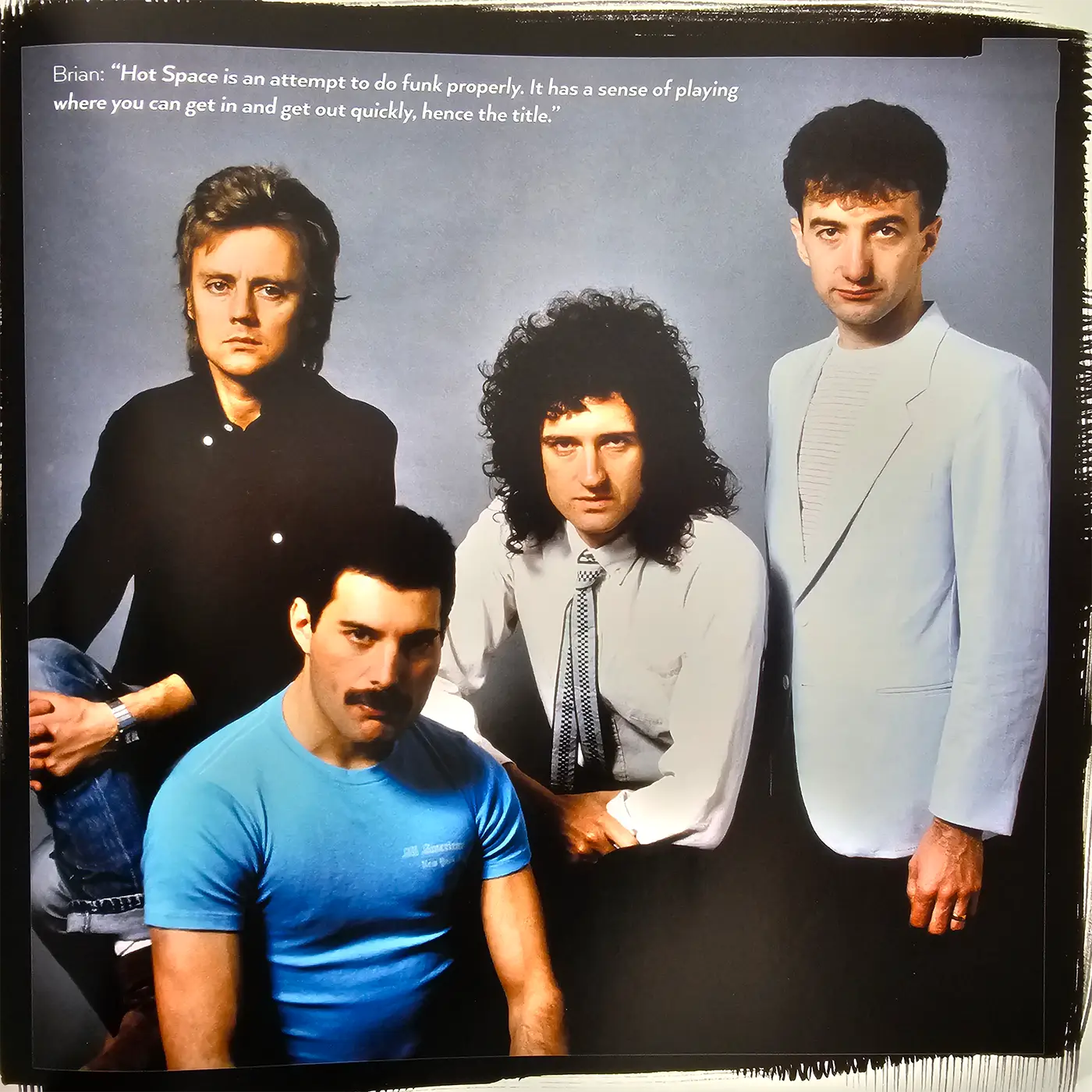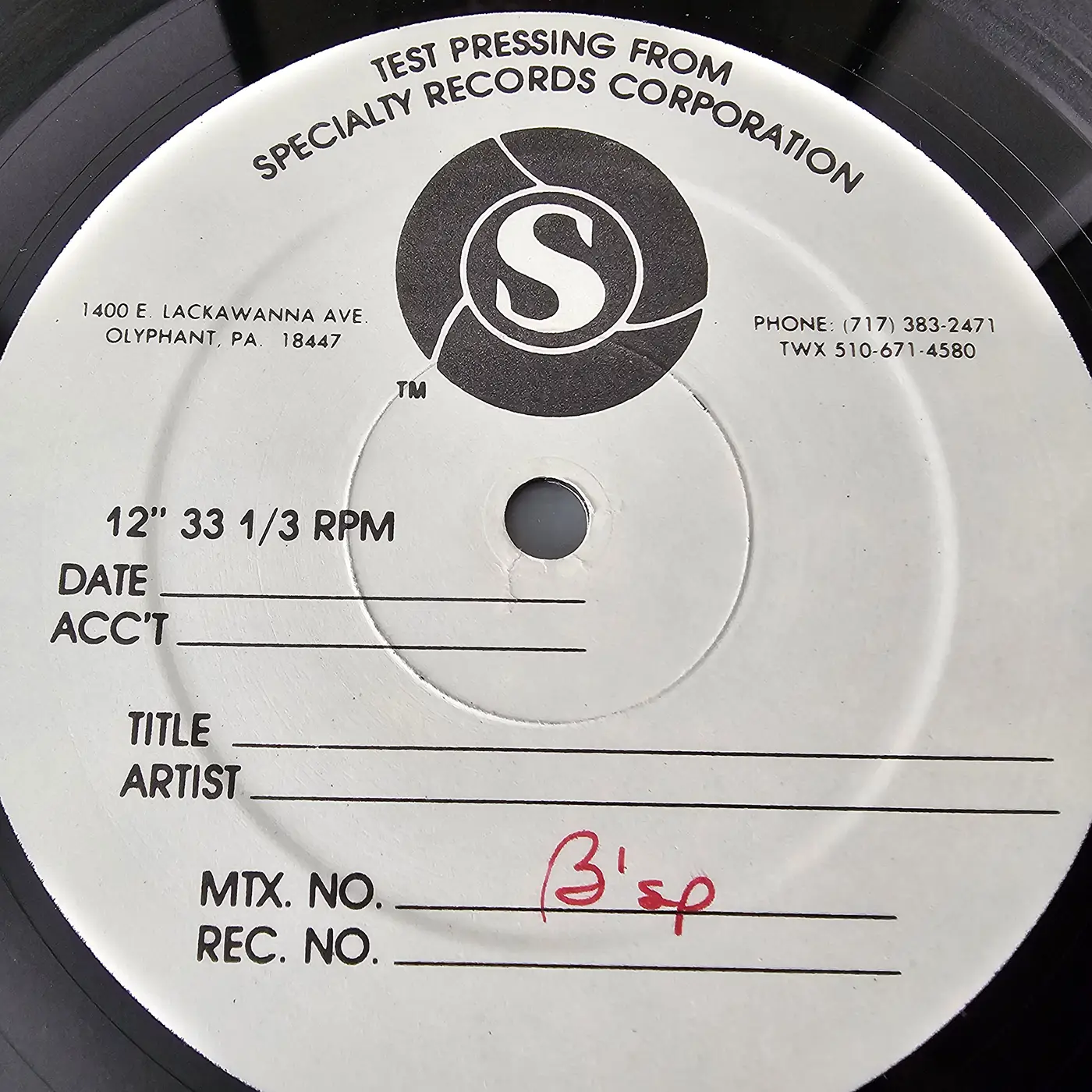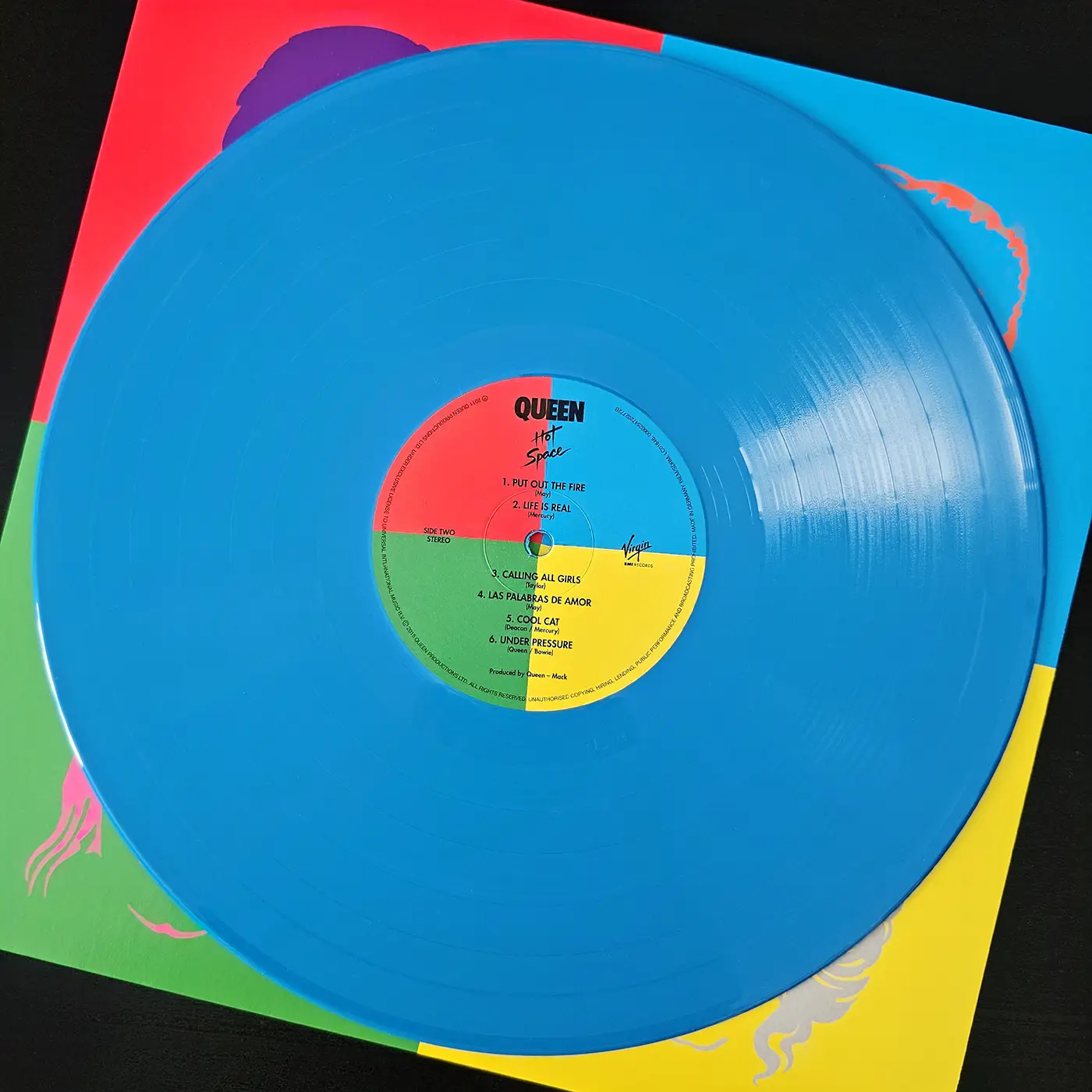Queen were arguably on an all-time high in 1980 after their album The Game and single Another One Bites The Dust topped the charts globally for many weeks. Especially in the US is was a huge chart topper, where it has sold four million copies to date.
The success of John Deacon’s Bites The Dust might have led to the band making the decision to record a more dance oriented album. Whatever the true decision making factors were, Queen returned in May 1982 with an album called Hot Space.
Hot Space is an attempt to do funk properly. It has a sense of playing where you can get in and out quickly, hence the title.
Brian May
It became an album which divided fans and foes as it made a notable shift in direction from their earlier work. Instead of the usual (hard) rock, they employed elements of disco, dance, funk, R&B, pop and new wave music. The album was preceded by a single called Under Pressure, featuring David Bowie. It was released seven months in advance of the album, in October 1981, and had the usual Queen trademarks with nice harmonies and great guitar work. The groovy bass line however hinted at what was to come.

Queen in 1982, taken from The Studio Collection LP box book
On the 5th of April 1982, 29 days before the UK release date, a test pressing was made for the US market with matrix numbers “EL-60128-A-1SP 1-1 STERLING” / “EL-60128-B-1SP 1-1 STERLING” on sides A and B respectively. As boring or uninteresting this may sound, this is a very exiting pressing as its B-side contains a song called Cool Cat which features David Bowie on vocals! Those familiar with the album will know that Bowie never featured on this track on the commercially released version.
Before going into more details, let’s first look at the disc itself. As expected, it comes without a sleeve. In my case, the disc is in a clear anti static sleeve. The disc bears the US Specialty Records Corporation labels, the company who made these pressings. They were standard test pressing labels from that period to which an employee would add any relevant information by hand. For this copy, on side A, the pressing date of “4-5-82” (American notion for 5 April 1982), account “ELK” (Elektra), artist “Queen”, “A’sp” which refers to the A-side matrix number and the catalogue number “EL-60128” where added. On side B, again on this particular copy, they only referred to the B-side matrix as “B’sp”.
Two close-ups of both labels can be seen below.


It is interesting to note that the commercially released disc has matrix numbers that start with “E1-60128” whereas this test pressing starts with “EL-60128”. It appears that the matrix number and thus catalogue number was changed from “EL” to “E1” only 4-6 weeks before its release in the US.
Based on a quote made by Brian in 1982, it seems that Bowie requested Queen to remove his vocals from Cool Cat a day before the album’s initial release date. This would then mean that a new master for the song and new vinyl stampers had to be created. The initial (to me unknown) release date had to be pushed back to what became the 4th of May 1982 for the UK and the 25th of May for the US.
Since the US created a test pressing with a wrong or rejected master on the 4th of April, was this the reason to delay the US release with 3 more weeks in comparison to the UK date? Or was the US going to get the Hot Space release later anyway? The arguably first test pressing, based on its matrix numbers featuring “1SP 1-1”, was after all only made on the 4th of April.
As per Brian’s 1982 quote, but also a quote made by Freddie in 1984, Bowie did not like his contribution to the song and had to be removed. Freddie more or less said that they just removed his vocal track, but there are more differences: the withdrawn version has more reverb on Freddie’s vocals, the intro is 7 seconds longer meaning Freddie’s vocals start around 16 seconds instead of 9, it features an extra line spoken by Freddie around 1:37 being “he used to know that” as a response to a Bowie line plus the outro lasts 11 seconds longer (containing some extra woooo’s by Freddie). The overall song is therefore a whopping 18 seconds longer than the approved version.
Obviously the withdrawn version also features Bowie who already starts 3 seconds into the song with some bum bum bum’s and later on some actual vocal lines. Though all in all his contributions are hardly that interesting, but they do add some character and atmosphere to the song.
For those who are curious, a decent quality rip can be found on YouTube. It first appeared on a 90s bootleg CD to a wider audience before the internet got a hold of it.
An unreleased demo version of this song with Bowie exists as well which features a similar or probably the same Bowie vocal track. This demo can be found on YouTube as well which is embedded below:
It remains unknown how many copies of this particular test pressing exist or were made. Test pressings from a later date exist which don’t feature the rejected master and are thus not to be confused with this rare piece of history.
Once the album was released, it was made available on LP and cassette in a beautiful full color non-gatefold cover and an arguably even better looking black inner sleeve. In 1986 the album got its first CD release, was remastered for CD in the US in 1991 with a bonus track and for Europe in 1994 without any bonus content. In 2011 the album was again remastered and re-issued as a deluxe 2CD edition which featured live songs, a B-side and a single remix as bonus audio.

The above photo shows some of these releases, from the top clockwise:
- 1982 EEC LP release
- 1982 US cassette release (with the black section at the bottom)
- 1991 Canadian cassette re-issue with bonus track
- 2011 2CD edition
- 2004 Japanese LP replica CD edition with a 2001 remaster
- 1986 German CD issue
- and the test pressing in the center
The black inner sleeve with the band’s faces in color was reproduced for CD editions in its booklet as shown below. Curiously enough, this black image was used as the front artwork for a cassette edition in Egypt and a few countries including Greece and Venezuela used it on the inside of a gatefold sleeve.



A tasty baby blue colored vinyl edition was released in 2015 as part of an 18LP box set, marking this the first widely available colored vinyl edition for this album. I say widely available because it was released on gray vinyl in Colombia in 1982 which is a rare and highly sought after collectors item today.
However, as rare as the gray edition may be, it arguably doesn’t come close to the featured test pressing which contains otherwise unreleased audio content! A studio reel to reel or master tape might be the next best candidate which could feature unreleased audio!








Leave a Reply